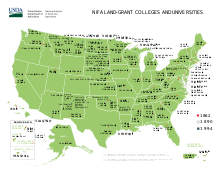
Back Land-grant-universitet Danish Land-grant University German Universidad concesionaria de tierras Spanish Land-grant university Finnish Land-grant university French Universitas hibah-tanah ID ランドグラント大学 Japanese 랜드그랜트 대학교 Korean Земјишно-грантовски универзитет Macedonian Land-grant-universitet NB
| This article is part of a series on |
| Education in the United States |
|---|
| Summary |
| Curriculum topics |
| Education policy issues |
| Levels of education |
|
|

A land-grant university (also called land-grant college or land-grant institution) is an institution of higher education in the United States designated by a state to receive the benefits of the Morrill Acts of 1862 and 1890,[1] or a beneficiary under the Equity in Educational Land-Grant Status Act of 1994.[2] There are 106 institutions in all: 57 which fall under the 1862 act, 19 under the 1890 act, and 35 under the 1994 act.
With Southerners absent during the Civil War,[clarification needed] Republicans in Congress set up a funding system that would allow states to modernize their weak higher educational systems. The Morrill Act of 1862 provided land in the western parts of North America that states sold to fund new or existing colleges and universities. The law specified the mission of these institutions: to focus on the teaching of practical agriculture, science, military science, and engineering—although "without excluding other scientific and classical studies".[3][4] This mission was in contrast to the historic practice of existing colleges which offered a narrow Classical curriculum based heavily on Latin, Greek and mathematics.[5]
The Morrill Act quickly stimulated the creation of new state colleges and the expansion of existing institutions to include these new mandates. By 1914, land-grant colleges and universities in every state gained political support and expanded the definition and scope of university curricula to include advanced research and outreach across the state. The federal Hatch Act of 1887 established an agricultural experiment station at each school to conduct research related to the needs of improving agriculture as well as a system to disseminate information to the farmers eager to innovate. By 1917, Congress funded the teaching of agricultural subjects in the new public high schools that were opening. The Second Morrill Act of 1890 further expanded federal funding for the land-grant colleges and funded the founding of new land-grant colleges for African Americans; these institutions are now among the nation's historically black colleges and universities (HBCUs). The 1994 expansion gave land-grant status and benefits to several tribal colleges and universities.[2] Most of the state schools were coeducational—indeed they led the way in that reform. A new department was added: home economics. However, relatively few women attended and they had second-class status.[6][7]
Ultimately, most land-grant schools became large state universities that offer a full spectrum of educational and research opportunities. Some land-grant colleges are private, including Cornell University and Tuskegee University.[8]

- ^ Collins, John Williams; O'Brien, Nancy P., eds. (2003). The Greenwood Dictionary of Education. Westport, CT: Greenwood Publishing Group. p. 227. ISBN 0-89774-860-3.
- ^ a b Greenwood Dictionary of Education. 2003. p. 235.
- ^ 7 U.S.C. § 304
- ^ What Is A Land-Grant College? (PDF), Washington State University, archived (PDF) from the original on November 6, 2020, retrieved July 12, 2011
- ^ John R. Thelin, A history of American higher education (JHU Press, 2011) pp 41–83.
- ^ Thelin, pp. 97-98.
- ^ Nathan M. Sorber, Land-Grant Colleges and Popular Revolt: The Origins of the Morrill Act and the Reform of Higher Education (2018) pp.155–171.
- ^ Brunner, Henry Sherman (1962). Land-grant Colleges and Universities, 1862-1962. Washington, D.C.: U.S. Government Printing Office. Archived from the original on September 4, 2022. Retrieved December 3, 2019.